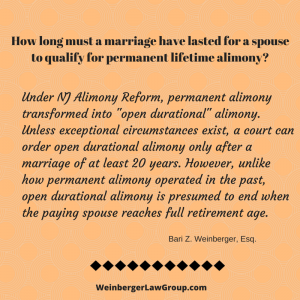NJ Supreme Court Case Addresses Questions About Alimony Awards for Stay-At-Home Spouses: Gnall v. Gnall, Part II
On July 29, 2015, the New Jersey Supreme Court decided the case of Gnall v. Gnall, an alimony case we first blogged about in November of 2014, following oral arguments. This case was decided under the New Jersey alimony statute as it existed prior to the recent reforms. The Appellate Division reversed a trial court’s award of durational alimony to plaintiff Elizabeth Gnall and sent the case back for consideration of a permanent alimony award. Defendant James Gnall appealed to the Supreme Court, which reversed the Appellate Division’s judgment and instructed the trial court to instead make new findings of fact and re-determine the appropriate alimony award based on those new findings.
Background and Trial Court Decision
James and Elizabeth Gnall had three children during an almost fifteen-year marriage. Elizabeth Gnall left her career as a computer programmer and systems analyst to become a stay-at-home mother shortly after the birth of their second child in 1999. By the time Elizabeth filed for divorce in 2008, James Gnall was earning more than $1 million dollars per year. The trial court awarded Elizabeth limited duration alimony for eleven years, in the amount of $18,000 per month (see “Types of Alimony” for more on alimony options). While experts for both sides testified that she was re-employable, there was no evidence that she would ever be able to earn anything approaching $18,000 per month.
In determining that permanent alimony was not appropriate, the trial judge made specific findings of fact relating to the statutory factors set out in N.J.S.A 2A:34-23(b), but appeared to rely primarily on the parties’ relatively young ages (both were 42 at the time of the divorce complaint) and the duration of the marriage, stating that although this almost fifteen-year marriage was certainly “not short-term,” it was also not a “twenty-five to thirty year” marriage. The court concluded that “the parties were not married long enough and are not old enough for [defendant] to be responsible to maintain that lifestyle permanently for [plaintiff].” Gnall v. Gnall, 432 N.J. Super. 129 (App. Div. 2013).
The Decision of the Appellate Division
Elizabeth appealed, claiming that the length of the marriage and her diminished employability resulting from her long status as a stay-at-home parent entitled her to permanent alimony. The Appellate Division agreed with the trial court that a fifteen-year marriage was “not short-term,” but disagreed with the court’s conclusion, indicating instead that an award of limited duration alimony was precluded in a marriage that was not short-term, and that the trial court was therefore required to consider a permanent alimony award. James Gnall then sought and was granted a review by the New Jersey Supreme Court.
The New Jersey Supreme Court Opinion
As discussed by the Court, New Jersey judges have broad discretion over when to award alimony, how much to award, and for how long. The Court explained that the purpose of permanent alimony is to allow a dependent spouse to continue the marital lifestyle. It is awarded based on the needs of the dependent spouse and the ability of the higher earning spouse to pay. Limited duration alimony has a similar purpose, and where all other statutory factors are equal, the length of a marriage determines which of these two types of alimony is appropriate.
The Gnall Court focused on the importance of adequately assessing all of the statutory alimony factors listed in N.J.S.A2A:34-23(b), and noted that both the trial court and the Appellate Division court elevated the length of the marriage above other factors, in spite of the fact that each court reached an opposite conclusion. In commenting that this was not a “twenty-five to thirty year” marriage, the trial court essentially stated that a fifteen year marriage was not long enough to justify an award of permanent alimony. By contrast, in commenting that a fifteen-year marriage was “not short-term” and that limited duration alimony was therefore precluded, the appellate court essentially created a “bright line rule” providing that fifteen years was automatically long enough to justify a permanent alimony award. The Supreme Court sent the matter back to the trial court for a redetermination of the appropriate type of alimony, with instructions to give due consideration to all of the statutory factors.
The Take-Away
Gnall v. Gnall has direct relevance only to the handful of alimony cases yet to be decided that were initiated under the law as it existed prior to alimony reform. Nevertheless, it is interesting to consider how the courts might analyze this type of case under the current version of the alimony statute. In a statement that now appears somewhat ironic, the Appellate Division court observed that: “there is no per se rule that permanent alimony is unwarranted unless the twentieth anniversary milestone is reached.” In essence, the revised statute created exactly such a rule, by providing that “For any marriage or civil union less than 20 years in duration, the total duration of alimony shall not, except in exceptional circumstances, exceed the length of the marriage or civil union.” Because it allows for consideration of exceptional circumstances, however, the statutory rule is slightly less rigid than a “bright line.” In evaluating the need for an adjustment to the duration of alimony, courts can consider the following circumstances:
– The ages of the parties at the time of the marriage or civil union and at the time of the alimony award;
– The degree and duration of the dependency of one party on the other party during the marriage or civil union;
– Whether a spouse or partner has a chronic illness or unusual health circumstance;
– Whether a spouse or partner has given up a career or a career opportunity or otherwise supported the career of the other spouse or partner;
– Whether a spouse or partner has received a disproportionate share of equitable distribution;
– The impact of the marriage or civil union on either party’s ability to become self-supporting, including but not limited to either party’s responsibility as primary caretaker of a child;
– Tax considerations of either party;
– Any other factors or circumstances that the court deems equitable, relevant and material.
N.J.S.A 2A:34-23(c).
Under the revised statute, Elizabeth Gnall would no longer have an argument supporting an award of permanent alimony, but she could argue for an award that exceeded the duration of her fifteen-year marriage, based especially on factors 2, 4 and 6, above.
An important caveat for stay-at-home parents looking to this case for guidance, is that at no level of review was there ever any suggestion that Elizabeth, whose youngest child was eleven years old at the time of the first appeal, should not be expected to resume employment. While there was some dispute regarding how much retraining she might require, she was always expected to rejoin the workforce, and was in fact imputed with a salary commensurate with re-entry positions in her former career. The unusual circumstance in this case was that due to James Gnall’s extremely high income, even though Elizabeth could anticipate eventually regaining a very respectable income herself, it was not expected to ever be enough to allow her to maintain the marital standard of living on her own.
Because the Supreme Court declined to comment on the provisions of the revised statute, other than to verify that those provisions were inapplicable to the case, any further analysis will have to await another case.
Do you have questions about New Jersey’s revised alimony statute and how it might be applicable to your situation? We can help. Please contact us to schedule your initial consultation.



